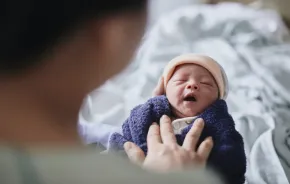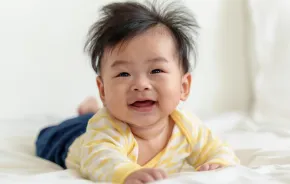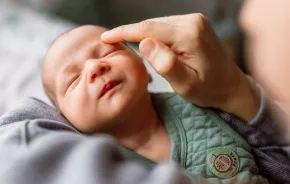
The first time Kristin Kalning and her husband adopted a child, the process took two years. Four years later, when they applied to adopt a second child from Ethiopia, they were told it would take at least twice as long. It was upsetting news for the growing family.
Then, Kalning went skiing. On the ski lift, she met a woman who’d just adopted her daughter from China. “When I asked, ‘Where’s your daughter?’ she said, ‘Oh, she’s off snowboarding. She has limb differences, but she snowboards.’”
Inspired, Kalning and her family decided to adopt a child with special needs, an option they’d already been considering. Within 12 months of making the decision, they were on their way home from China with their second son, who was born with a cleft palate. He turned 3 the day the family landed in Seattle.
“We were so lucky to be matched with him,” Kalning says. “We cannot imagine our lives without his joyful, smiling face.”
The ever-changing world of adoption
In the past decade, the landscape of international adoption has changed drastically, with new adoptions decreasing in the United States by 75 percent between 2004 and 2015. That’s nearly 23,000 children adopted by American families in 2004, compared to a little more than 5,600 children in 2015, according to the U.S. State Department.
Part of the decline is due to the U.S.’s 2008 adoption of the Hague Adoption Convention, an international treaty meant to prevent the abduction and trafficking of kids. American adoption agencies must now be Hague-accredited, a lengthy process full of protections for children and parents, both biological and adoptive.
“For prospective adoptive families, the biggest impact is that families can no longer adopt internationally without the assistance of a U.S. accredited agency,” says Greg Eubanks, the CEO of the World Association for Children and Parents (WACAP). Before, families could work directly with an orphanage overseas.
Countries have also been changing their rules, including three nations that were once among the most popular for American adoptive families: Guatemala, Russia and China.
U.S. adoptions from Guatemala have all but stopped since 2007 due to concerns of corruption, while in 2013, Russia imposed a ban on all adoptions to the U.S. for political reasons. Meanwhile, in China, where adoption by Americans is still legal following the Hague Convention, U.S. adoptions have dropped by more than half compared to 2004. The reasons are many, says Eubanks.
For one, China has relaxed its one-child policy, while at the same time, domestic Chinese adoption has grown more popular. Now, he explains, WACAP more often sees children abandoned because of medical or developmental challenges. “American families are stepping forward to end [these children’s] wait of families and provide [the children with] much-needed medical or therapeutic care,” Eubanks says.
Finding a new home
The term “special needs” means many things to many different people. In the world of adoption, it most often refers to a child who is older than age 6 and/or who may have a medical diagnosis, developmental delay or significant history of complex trauma, Eubanks says.
“Children who have special needs have always been a subgroup of children adopted internationally,” he adds. “They are now the majority.”
Of course, deciding to adopt a child with special needs can lead to complicated conversations during an already complicated time.
“Once we decided we could accept a child with medical needs, checking off what you’d accept on a laundry list of deformities and medical issues weighed heavily on us,” says Seattle father Tom Seery.
As the CEO of RealSelf, an online community for learning about cosmetic surgery, Seery was comfortable with surgically repairable conditions. His older son was born with a cleft lip and cleft palate, while his younger son has microtia (one ear is underdeveloped).
Beyond special needs, there’s figuring out how to make an adopted child feel both part of a new culture and connected to the history of a country thousands of miles away.
Initially, Seery admits, he and his wife were so consumed with their children’s medical needs that he wasn’t thinking about cultural cohesiveness. That’s since changed. “The judge who declared our adoption official said, ‘Congratulations! You’re now an Asian-American family,’” says Seery, who is Caucasian. “I’m trying to look at it through that lens.”
Make no mistake, adopting internationally isn’t for wimps, as Seery’s wife likes to say. “Adoption means working to become a great parent. You’ll need emotional maturity so you can admit when you are really struggling,” Seery says. “Internationally adopted children are different; they’ve gone through traumas and abandonment. You can’t assume giving them birthday cake and encouragement is enough. You’ll have to do more and do things differently.”
Mill Creek mom Amy Wolf seconds that. One of her adopted children, who uses a wheelchair part-time, was almost 10 when she arrived from China.
“It’s been really hard and sad and fun to hear her stories because she had a whole life before us,” Wolf says. “All adopted children have to grieve the loss of whatever they had, even if what they had was eating out of garbage cans and being smacked around. Still, she’s the most joyful person I’ve ever met.”
Wolf says parenting her two adopted children is similar to parenting her two biological children.
“All parents are always figuring out, ‘How do we do this? How do we journey together?’” she says. “The truth is, I’m always trying to get my husband to say yes to one more [adoption]. I would do it again in a heartbeat — even the hard stuff.”
Stars in the sky
For those interested in international adoption, Eubanks recommends contacting an agency. “We’re going to find an intersection between your passions and skill set and a child’s needs,” he says.
An agency supports families before, during and after adoption, answering questions ranging from how much it costs (an average of between $30,000 and $35,000, with some options costing as much as $60,000) to what life looks like for an adoptive family 5, 10, 20 years into the future.
Local organizations such as Adoptive Friends and Families of Greater Seattle and the University of Washington’s Center for Adoption Medicine offer support for both parents and children.
So, what keeps families going? Why chose international adoption despite the red tape, the paperwork, the geopolitical power plays? Simple: family.
“Every child deserves a family that’s going to be completely, irrationally nuts about them, whether they have a heart defect, have experienced complex trauma or live 10 time zones away,” Eubanks says. “Families that adopt are responding to needs that they see as humans and their motivations are as many and as individual as the stars in the sky.”











